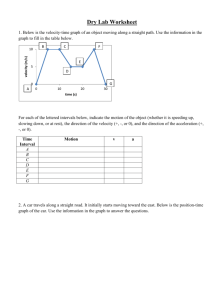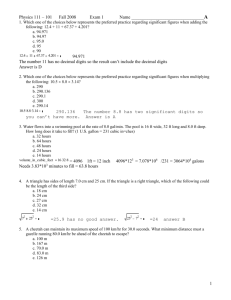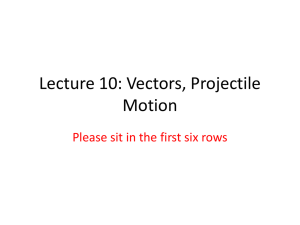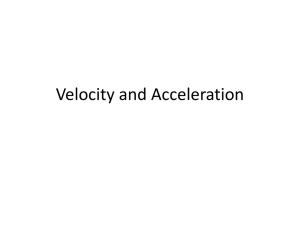V.3 - Velocity and Acceleration of Vector
advertisement
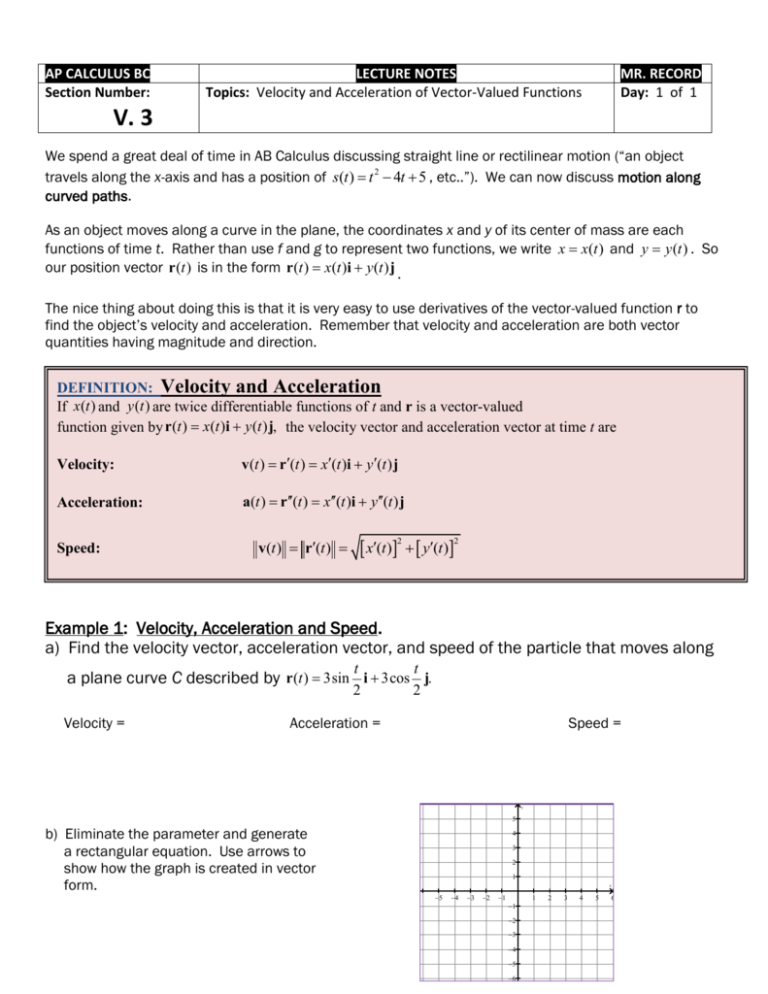
AP CALCULUS BC Section Number: LECTURE NOTES Topics: Velocity and Acceleration of Vector-Valued Functions MR. RECORD Day: 1 of 1 V. 3 We spend a great deal of time in AB Calculus discussing straight line or rectilinear motion (“an object travels along the x-axis and has a position of s(t ) t 2 4t 5 , etc..”). We can now discuss motion along curved paths. As an object moves along a curve in the plane, the coordinates x and y of its center of mass are each functions of time t. Rather than use f and g to represent two functions, we write x x(t ) and y y (t ) . So our position vector r (t ) is in the form r (t ) x(t )i y (t ) j . The nice thing about doing this is that it is very easy to use derivatives of the vector-valued function r to find the object’s velocity and acceleration. Remember that velocity and acceleration are both vector quantities having magnitude and direction. DEFINITION: Velocity and Acceleration If x(t ) and y (t ) are twice differentiable functions of t and r is a vector-valued function given by r (t ) x(t )i y (t ) j, the velocity vector and acceleration vector at time t are Velocity: v(t ) r(t ) x(t )i y(t ) j Acceleration: a(t ) r(t ) x(t )i y(t ) j Speed: v(t ) r(t ) x(t ) y(t ) 2 2 Example 1: Velocity, Acceleration and Speed. a) Find the velocity vector, acceleration vector, and speed of the particle that moves along t 2 t 2 a plane curve C described by r (t ) 3sin i 3cos j. Velocity = Acceleration = Speed = y b) Eliminate the parameter and generate a rectangular equation. Use arrows to show how the graph is created in vector form. x c) When you find the velocity at seconds, what is your answer? d) What does part (c)’s answer mean? e) Interpret the speed you found in part (a). f) What is the acceleration at seconds? What does this mean? Example 2: Motion Along A Curve - I Sketch the path of an object moving along the plane curve given by r(t ) (t 2 3)i tj and find the velocity and acceleration vectors and speed at t = 0 and t = 2. Sketch the velocity and acceleration vectors on your curve below. Example 3: Motion Along A Curve - II Sketch the path of an object moving along the plane curve given by r (t ) et i ln tj and find the velocity and acceleration vectors and speed at t = 1. Sketch the velocity and acceleration vectors on your curve below. Example 4: Motion Along A Curve - III A particle starts at rest from the point (1,2) with an acceleration vector of a(t ) i 2 j . Find the location of the particle after 2 seconds. a) What does “the particle is at rest” mean? b) Since the particle starts at (1,2), write its position vector s at time zero. c) Find the velocity vector v (t ) by integrating the acceleration vector. Remember the constant. d) Find the constants for the vector , v (t ) . e) Find the position vector s (t ) by integrating the velocity vector. Remember the constant. f) Find the constants for the vector, s (t ) . g) Write the position vector. h) Find the position at 2 seconds. Remember that when an object is subjected to gravity, its position s above the ground is given by s 16t 2 v0t s0 . With that in mind, we can solve some vector motion problems that you may have done in Pre-Calculus using parametric equations. Example 5: Application of Motion- I A baseball is hit 3 feet above the ground at 100 feet/second at an angle of 45 to the ground. Find the maximum height of the ball and determine if it will clear a 12 foot fence located 300 feet from home plate. a) Write an expression for the horizontal component of the ball vector. b) Write an expression for the vertical component of the ball vector. c) When does the ball reach its maximum height? d) How high does the ball reach? e) The ball has traveled 300 feet when its horizontal component equals 300. When does this occur? f) How high is the ball at 300 feet? Is it a homerun? Example 6: Application of Motion- II The nozzle of a hose discharges water with a velocity of 40 feet per second. Determine how high the water rises is the hose makes an angle of 60 with the ground. Also determine how far the water will shoot in a horizontal distance. Example 7: Application of Motion- III A projectile is fired from the ground level at an angle of 10 the horizontal. Find the minimum velocity necessary if the projectile is to have a range of 100 feet.



